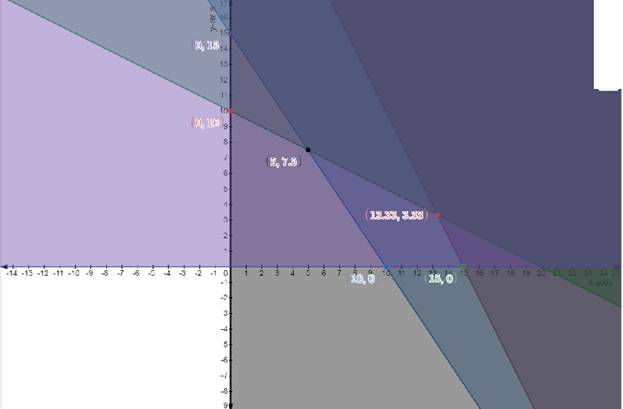
(A)
To find:
The solution set of the system of inequalities for the different amounts of food
(A)
Answer to Problem 70E
Explanation of Solution
Given:
The equation
Concept used:
Replace the inequality sign and sketch the graph of the resulting equation (use a dashed line for <or> and a solid line for
Test one point in each of the region formed by the graph
If the point satisfies the inequality then shade the entire region to denote that every point in the region satisfies the inequality
Calculation:
Let
Both foods must be equal or greatorthan
The system of inequality
(B)
To find:
The solution set of the system of inequalities for the different amounts of food
(B)
Answer to Problem 70E
Explanation of Solution
Given:
The equation
Concept used:
Replace the inequality sign and sketch the graph of the resulting equation (use a dashed line for < or > and a solid line for
Test one point in each of the region formed by the graph
If the point satisfies the inequality then shade the entire region to denote that every point in the region satisfies the inequality
Calculation:
Let
Test one point in each of the region formed by the graph
If the point satisfies the inequality then shade the entire region to denote that every point in the region satisfies the inequality
Draw the table
Draw the graph

(C)
To find:
The solution set of the system of inequalities for the different amounts of food
(C)
Answer to Problem 70E
Explanation of Solution
Given:
The equation
Concept used:
Replace the inequality sign and sketch the graph of the resulting equation (use a dashed line for < or > and a solid line for
Test one point in each of the region formed by the graph
If the point satisfies the inequality then shade the entire region to denote that every point in the region satisfies the inequality
Calculation:
Let
Take any two points that is the region bounded from part (b)
In take of
In take of
Chapter 7 Solutions
EBK PRECALCULUS W/LIMITS
- Find the length of the following curve. 3 1 2 N x= 3 -y from y 6 to y=9arrow_forward3 4/3 3213 + 8 for 1 ≤x≤8. Find the length of the curve y=xarrow_forwardGiven that the outward flux of a vector field through the sphere of radius r centered at the origin is 5(1 cos(2r)) sin(r), and D is the value of the divergence of the vector field at the origin, the value of sin (2D) is -0.998 0.616 0.963 0.486 0.835 -0.070 -0.668 -0.129arrow_forward
- 10 The hypotenuse of a right triangle has one end at the origin and one end on the curve y = Express the area of the triangle as a function of x. A(x) =arrow_forwardIn Problems 17-26, solve the initial value problem. 17. dy = (1+ y²) tan x, y(0) = √√3arrow_forwardcould you explain this as well as disproving each wrong optionarrow_forward
- could you please show the computation of this by wiresarrow_forward4 Consider f(x) periodic function with period 2, coinciding with (x) = -x on the interval [,0) and being the null function on the interval [0,7). The Fourier series of f: (A) does not converge in quadratic norm to f(x) on [−π,π] (B) is pointwise convergent to f(x) for every x = R П (C) is in the form - 4 ∞ +Σ ak cos(kx) + bk sin(kx), ak ‡0, bk ‡0 k=1 (D) is in the form ak cos(kx) + bk sin(kx), ak 0, bk 0 k=1arrow_forwardSolve the equation.arrow_forward
 Calculus: Early TranscendentalsCalculusISBN:9781285741550Author:James StewartPublisher:Cengage Learning
Calculus: Early TranscendentalsCalculusISBN:9781285741550Author:James StewartPublisher:Cengage Learning Thomas' Calculus (14th Edition)CalculusISBN:9780134438986Author:Joel R. Hass, Christopher E. Heil, Maurice D. WeirPublisher:PEARSON
Thomas' Calculus (14th Edition)CalculusISBN:9780134438986Author:Joel R. Hass, Christopher E. Heil, Maurice D. WeirPublisher:PEARSON Calculus: Early Transcendentals (3rd Edition)CalculusISBN:9780134763644Author:William L. Briggs, Lyle Cochran, Bernard Gillett, Eric SchulzPublisher:PEARSON
Calculus: Early Transcendentals (3rd Edition)CalculusISBN:9780134763644Author:William L. Briggs, Lyle Cochran, Bernard Gillett, Eric SchulzPublisher:PEARSON Calculus: Early TranscendentalsCalculusISBN:9781319050740Author:Jon Rogawski, Colin Adams, Robert FranzosaPublisher:W. H. Freeman
Calculus: Early TranscendentalsCalculusISBN:9781319050740Author:Jon Rogawski, Colin Adams, Robert FranzosaPublisher:W. H. Freeman
 Calculus: Early Transcendental FunctionsCalculusISBN:9781337552516Author:Ron Larson, Bruce H. EdwardsPublisher:Cengage Learning
Calculus: Early Transcendental FunctionsCalculusISBN:9781337552516Author:Ron Larson, Bruce H. EdwardsPublisher:Cengage Learning





